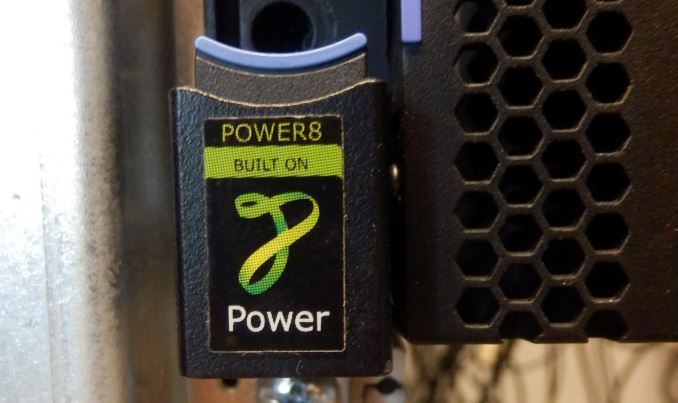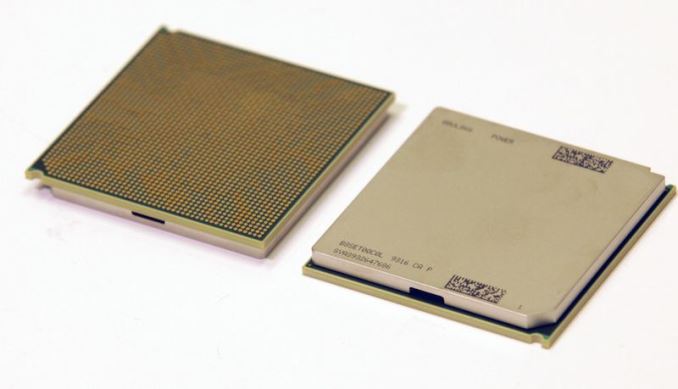The IBM POWER8 Review: Challenging the Intel Xeon
by Johan De Gelas on November 6, 2015 8:00 AM EST- Posted in
- IT Computing
- CPUs
- Enterprise
- Enterprise CPUs
- IBM
- POWER
- POWER8
Comparing Benchmarks: AT vs IBM
Before we close things out, let's spend a moment summarizing our results and comparing the performance we saw to the kind of performance advantages that IBM advertises POWER8 is capable of.
From a high level perspective, the S822L is more expensive and consumes a lot more power than a comparable Xeon system.
With limited optimization and with the current Ubuntu 15.04, the performance-per-watt ratio favors Intel even more as the POWER8 barely outperforms the very efficient 120W TDP Xeons. So there is no denying that the Intel systems offer a superior performance/watt ratio.
However, it would be unfair to base our judgement on our first attempt as we have to admit this our first real attempt to benchmark and test the POWER8 platform. It is very likely that we will manage to extract quite a bit more performance out of the system on our second attempt. IBM POWER8 also has a big advantage in memory bandwidth. But we did not manage to port OpenFOAM to the POWER platform, probably the most likely candidate for leveraging that advantage.
We are less convinced that the POWER8 platform has a huge "raw CPU compute advantage," contrary to what for example IBM's SPECJBB (85% faster ) and SAP (29% faster) results seem to suggest.
For example, IBM's own SPECjEnterprise®2010 benchmarking shows that:
- Two Xeon E5-2697 v3, 14 cores at 2.6-3.1 GHz score 19282
- Two POWER8, 12 cores at 3.5-3.8 GHz score 22543
SAP is "low IPC" (hard to run many instructions in parallel in one thread) software that benefits much from low latency caches. The massive L3-cache (12-cores, 96 MB) and huge thread count are probably giving the IBM POWER8 the edge. The RAM bandwidth also helps, but in a lesser degree. IBM clearly built POWER8 with this kind of software in mind. We had individual threadcount intensive benchmarks (LZMA decompression) and L3-cache sensitive benchmarks (ElasticSearch), but t o be fair to IBM, none of our benchmarks leveraged the three strongest points (threadcount, L3-cache size and memory bandwidth) all at once like SAP.
SPECJBB2013 has recently been discontinued as it was not reliable enough. We tend to trust the jEnterprise test a lot more. In any case, the best POWER8 has a 17% advantage there.
Considering that the POWER8 inside that S824 has 20% more cores and a 3% higher clockspeed, our 3.4 GHz 10-core CPU would probably be slightly behind the Xeon E5-2697 v3. We found out that the 10-core POWER8 is slightly faster than Xeon E5-2695 v3. The Xeon E5-2695 v3 is very similar to the E5-2697 v3, it is just running at a 10% lower clockspeed (All core turbo: 2.8GHz vs 3.1GHz). So all in all, our benchmarks seems to be close to the official benchmarks, albeit slightly lower.
Closing Thoughts: A Mix of Xeon "E5" and "E7"
So let's sum things up. The IBM S822L is definitely not a good choice for those looking to lower their energy bills or operate in a location with limited cooling. The pricing of the CDIMMs causes it to be more expensive than a comparable Xeon E5 based server. However, you get something in return: the CDIMMs should offer higher reliability and are more similar to the memory subsystem of the E7 than the E5. Also, PCIe adapters are hot-pluggable on the S822L and can be replaced without bringing down the system. With most Xeon E5 systems, only disks, fans and PSU are hot-pluggable.
In a number of ways then, the S822L is more a competitor to dual Xeon E7 systems than it is to dual Xeon E5 systems. In fact, a dual Xeon E7 server consumes in the 600-700W range, and in that scenario the power usage of S822L (700-800W) does not seem outrageous anymore.
The extra reliability is definitely a bonus when running real time data analytics or virtualization. A failing memory chip may cost a lot when you running fifty virtual machines on top of a server. Even in some HPC or batch data analytics applications where you have to wait for hours for a certain result that is being computed in an enormous amount of memory, the cost savings of being able to survive a failing memory chip might be considerable.
One more thing: for those who need full control, the fact that every layer in the software stack is open makes the S822L very attractive. For now, the available "OpenCompute" Xeon servers that are also "open" seem to mostly density optimized servers and the openess seems limited on several levels. Rackspace felt that the current OpenCompute servers are not "open enough", and went for OpenPOWER servers instead. In all those markets, the S822L is very interesting alternative to the dual Xeon E5 servers.
Ultimately however, the performance-per-dollar Xeon E5 competitors will most likely be OpenPOWER third party servers. Those servers do not use CDIMMS, but regular RDIMMs. Other components such as disks, networkcards and PSUs will probably be cheaper but potentially also slightly less reliable.
All in all, the arrival of OpenPOWER servers is much more exciting than most of us anticipated. Although the IBM POWER8 servers can not beat the performance/watt ratio of the Xeon, we now have a server processor that is not only cheaper than Intel's best Xeons, but that can also keep up with them. Combine that with the fact that IBM has lined up POWER8+ for next year and a whole range of server vendors is building their own POWER8 based servers, and we have a lot to look forward to!












146 Comments
View All Comments
Der2 - Friday, November 6, 2015 - link
Life's good when you got power.BlueBlazer - Friday, November 6, 2015 - link
Aye, the power bills will skyrocket.Brutalizer - Friday, November 13, 2015 - link
It is confusing that sometimes you are benchmarking cores, and sometimes cpus. The question here is "which is the fastest cpu, x86 or POWER8" - and then you should bench cpu vs cpu. Not core vs core. If a core is faster than another core says nothing, you also need to know how many cores there are. Maybe one cpu has 2 cores, and the other has 1.000 cores. So when you tell which core is fastest, you give incomplete information so I still have to check up how many cores and then I can conclude which cpu is fastest. Or can I? There are scaling issues, just because one benchmark runs well on one core, does not mean it runs equally well when run on 18 cores. This means I can not extrapolate from one core to the entire cpu. So I still am not sure which cpu is fastest as you give me information about core performance. Next time, if you want to talk about which cpu is faster, please benchmark the entire cpu. Not core, as you are not talking about which core is faster.Here are 20+ world records by SPARC M7 cpu. It is typically 2-3x faster than POWER8 and Intel Xeon, all the way up to >10x faster. For instance, M7 achieves 87% higher saps than E5-2699v3.
https://blogs.oracle.com/BestPerf/
The big difference between POWER and SPARC vs x86, is scalability and RAS. When I say scalability, I talk about scale-up business Enterprise servers with as many as 16- or even 32-sockets, running business software such as SAP or big databases, that require one large single server. SGI UV2000 that scales to 10.000s of cores can only run scale-out HPC number crunching workloads, in effect, it is a cluster. There are no customers that have ever run SGI UV2000 using enterprise business workloads, such as SAP. There are no SAP benchmarks nor database benchmarks on SGI UV2000, because they can only be used as clusters. The UV2000 are exclusively used for number crunching HPC workloads, according to SGI. If you dont agree, I invite you to post SAP benchmarks with SGI UV2000. You wont find any. The thing is, you can not use a small cluster with 10.000 cores and replace a big 16- or 32-socket Unix server running SAP. Scale-out clusters can not run SAP, only scale-up servers can. There does not exist any scale-out clustered SAP benchmarks. All the highest SAP benchmarks are done by single large scale-up servers having 16- or 32-sockets. There are no 1.000-socket clustered servers on the SAP benchmark list.
x86 is low end, and have for decades stopped at maximum 8-sockets (when we talk about scale-up business servers), and just recently we see 16- and 32- sockets scale-up business x86 servers on the market (HP Kraken, and SGI UV300H) but they are brand new, so performance is quite bad. It takes a couple of generations until SGI and HP have learned and refined so they can ramp up performance for scale-up servers. Also, Windows and Linux has only scaled to 8-sockets and not above, so they need a major rewrite to be able to handle 16-sockets and a few TB of RAM. AIX and Solaris has scaled to 32-sockets and above for decades, were recently rewritten to handle 10s of TB of RAM. There is no way Windows and Linux can handle that much RAM efficiently as they have only scaled to 8-sockets until now. Unix servers scale way beyond 8-sockets, and perform very well doing so. x86 does not.
The other big difference apart from scalability is RAS. For instance, for SPARC and POWER you can hot swap everything, motherboards, cpu, RAM, etc. Just like Mainframes. x86 can not. Some SPARC cpus can replay instructions if something went wrong. x86 can not.
For x86 you typically use scale-out clusters: many cheap 1-2 socket small x86 servers in a huge cluster just like Google or Facebook. When they crash, you just swap them out for another cheap server. For Unix you typically use them as a single scale-up server with 16- or 32-sockets or even 64-sockets (Fujitsu M10-4S) running business software such as SAP, they have the RAS so they do not crash.
zeeBomb - Friday, November 6, 2015 - link
New author? Niiiice!Ryan Smith - Friday, November 6, 2015 - link
Ouch! Poor Johan.=(Johan is in fact the longest-serving AT editor. He's been here almost 11 years, just a bit longer than I have.
hans_ober - Friday, November 6, 2015 - link
@Johan you need to post this stuff more often, people are forgetting you :)JohanAnandtech - Friday, November 6, 2015 - link
well he started with "niiiiice". Could have been much worse. Hi zeeBomb, I am Johan, 43 years old and already 17 years active as a hardware editor. ;-)JanSolo242 - Friday, November 6, 2015 - link
Reading Johan reminds me of the days of AcesHardware.com.joegee - Friday, November 6, 2015 - link
The good old days! I remember so many of the great discussions/arguments we had. We had an Intel guy, an AMD guy, and Charlie Demerjian. Johan was there. Mike Magee would stop in. So would Chris Tom, and Kyle Bennett. It was an awesome collection of people, and the discussions were FULL of real, technical points. I always feel grateful when I think back to Ace's. It was quite a place.JohanAnandtech - Saturday, November 7, 2015 - link
And many more: Paul Demone, Paul Hsieh (K7-architect), Gabriele svelto ... Great to see that people remember. :-)